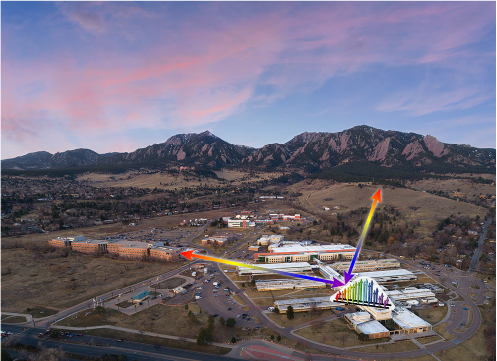Jul 1 2021
Scientists from the National Institute of Standards and Technology (NIST) have improved their laser frequency-comb instrument to make parallel measurements of three airborne greenhouse gases, such as carbon dioxide, nitrous oxide and water vapor, and also the measurement of major air pollutants, like carbon monoxide and ozone.
 NIST researchers used a laser frequency-comb instrument (illustration at lower right) to simultaneously measure three airborne greenhouse gases—nitrous oxide, carbon dioxide, and water vapor—plus the major air pollutants ozone and carbon monoxide over two round-trip paths (arrows) from a NIST building in Boulder, Colorado, to a reflector on a balcony of another building, and another reflector on a nearby hill. Image Credit: N. Hanacek/National Institute of Standards and Technology (NIST).
NIST researchers used a laser frequency-comb instrument (illustration at lower right) to simultaneously measure three airborne greenhouse gases—nitrous oxide, carbon dioxide, and water vapor—plus the major air pollutants ozone and carbon monoxide over two round-trip paths (arrows) from a NIST building in Boulder, Colorado, to a reflector on a balcony of another building, and another reflector on a nearby hill. Image Credit: N. Hanacek/National Institute of Standards and Technology (NIST).
NIST's dual-comb technology, coupled with a previous system version that quantifies methane, can now detect all the four major greenhouse gases. This may aid in understanding and tracking the emissions of these heat-trapping gases linked to climate change. The latest comb system can also help determine the urban air quality.
The NIST instruments can detect gas signatures by accurately quantifying the amounts of light absorbed at every color in the broad laser spectrum, as uniquely prepared rays trace the path through the atmosphere. Existing applications include measuring emissions from livestock and detecting leaks from oil and gas installations.
Compared to traditional sensors that sample air at certain locations, the new comb systems can quantify a larger volume of gases. These systems also provide greater accuracy and a more extended range than analogous techniques using other light sources.
The latest advancement from NIST moves the light spectrum investigation from the near-infrared range into the mid-infrared range, facilitating the identification of additional and different types of gases. While the previously developed near-infrared comb systems can identify methane and carbon dioxide, they could not detect nitrous oxide, carbon monoxide or ozone.
The researcher demonstrated the latest system over round-trip paths measuring 600 m and 2 km in length. The light from the two frequency combs was integrated into an optical fiber and transmitted from a telescope placed at the top of a NIST building in Boulder, Colorado.
While one beam was sent to a reflector placed at a balcony of another building, the other was transmitted to a reflector located on a hill. The comb light ricocheted off the reflector and returned to the original site to analyze and identify the atmospheric gases.
A frequency comb is a highly accurate “ruler” used to measure the precise colors of light. A different color is identified by each comb “tooth.” To reach the mid-infrared portion of the spectrum, a major component is a periodically poled lithium niobate, a uniquely designed crystal material that changes light between two colors.
In this experiment, the system first divided the near-infrared light from one comb into two branches, then applied unique fiber and amplifier to expand and move the spectrum of every branch differently and also to boost power, and finally recombined the branches in the crystal. This generated a mid-infrared light at a lower frequency, or longer wavelength, indicating the variation between the original colors in both branches.
The system was sufficiently accurate to capture the difference in atmospheric levels of all quantified gases and corresponded with the results obtained from a traditional point sensor for nitrous oxide and carbon monoxide. One major benefit of the simultaneous detection of multiple samples is the potential to quantify the correlations between them. For instance, the quantified ratios of carbon dioxide to nitrous oxide corresponded well with other analyses of emissions from traffic.
The ratio of surplus carbon monoxide against carbon dioxide also agreed with similar urban analyses, but this accounted for only one-third of levels estimated by the U.S. National Emissions Inventory (NEI). Such levels offer a measure of the efficient combustion of fuel in emission sources, including cars.
The NIST measurements, which agree with other studies indicating the presence of a lower concentration of atmospheric carbon monoxide than predicted by NEI, put the first hard numbers on the “inventories” or reference levels of pollutants in the Boulder-Denver region.
The comparison with the NEI shows how hard it is to create inventories, especially that cover large areas, and that it is critical to have data to feed back to the inventories.
Kevin Cossel, Lead Author, National Institute of Standards and Technology
“This isn’t something that will directly impact most people on a day-to-day basis — the inventory is just trying to replicate what is actually happening. However, for understanding and predicting air quality and pollution impacts, modelers do rely on the inventories, so it is critical that the inventories be correct,” Cossel added.
The researchers have planned to further enhance the new comb instrument and are aiming to extend the reach to even longer distances, as previously shown for the infrared system. The team has also planned to enhance the detection sensitivity by boosting the light power and other tweaks, to facilitate the detection of more gases.
They are also exploring ways to make the system more robust and compact. Such developments will provide a deeper insight into air quality, particularly the interplay of factors affecting the formation of ozone.
The study was financially supported by the Defence Advanced Research Projects Agency and the NIST Special Programs Office.
Journal Reference:
Giorgetta, F. R., et al. (2021) Open-path Dual-comb Spectroscopy for Multispecies Trace Gas Detection in the 4.5 μm to 5 μm Spectral Region. Laser and Photonics Review. doi.org/10.1002/lpor.202000583.